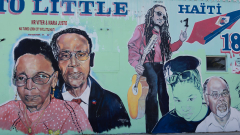A development towers over the Lyric Theater in Miami’s Overtown neighborhood.
Greg Iacurci
MIAMI — Nicole Crooks stood in the plaza of the historic Lyric Theater, a royal blue hat shielding her from the midday sun that baked Miami.
In its heyday, the theater, in the city’s Overtown neighborhood, was an important cultural hub for the Black community. James Brown, Sam Cooke, Ray Charles, Aretha Franklin and Ella Fitzgerald performed there, in the heart of “Little Broadway,” for esteemed audience members such as Jackie Robinson and Joe Louis.
Now, on that day in mid-March, the towering shell of a future high-rise development and a pair of yellow construction cranes loomed over the cultural landmark. It’s a visual reminder of the changing face of the neighborhood — and rising costs for longtime residents.
Located inland, far from prized beachfront real estate, Overtown was once shunned by developers and wealthy homeowners, said Crooks, a community engagement manager at Catalyst Miami, a nonprofit focused on equity and justice.
Nicole Crooks stands in the plaza of the Lyric Theater in Overtown, Miami.
Greg Iacurci
But as Miami has become ground zero for climate change, Overtown has also become a hot spot for developers fleeing rising seas and coastal flood risk, say climate experts and community advocates.
That’s because Overtown — like districts such as Allapattah, Liberty City, Little Haiti and parts of Coconut Grove — sits along the Miami Rock Ridge. This elevated limestone spine is nine feet above sea level, on average — about three feet higher than Miami’s overall average.
A development boom in these districts is changing the face of these historically Black neighborhoods and driving up prices, longtime residents tell CNBC. The dynamic is known as “climate gentrification.”
More from Personal Finance:
Why your finances aren’t insulated from climate change
People are moving to Miami and building there despite climate risk
Here’s how to buy renewable energy from your electric utility
Gentrification due to climate change is also happening in other parts of the U.S. and is one way in which climate risks disproportionately fall on people of color.
“More than anything, it’s about economics,” Crooks said of the encroachment of luxury developments in Overtown, where she has lived since 2011. “We’re recognizing that what was once prime real estate [on the coast] is not really prime real estate anymore” due to rising seas.
If Miami is ground zero for climate change, then climate gentrification makes Overtown and other historically Black neighborhoods in the city “ground zero of ground zero,” Crooks said.
Why the wealthy ‘have an upper hand’
When a neighborhood gentrifies, residents’ average incomes and education levels, as well as rents, rise rapidly, said Carl Gershenson, director of the Princeton University Eviction Lab.
Because of how those elements correlate, the outcome is generally that the white population increases and people of color are priced out, he said.
Gentrification is “inevitable” in a place such as Miami because so many people are moving there, including many wealthy people, Gershenson said.
But climate change “molds the way gentrification is going to happen,” he added.
Part of the building site of the Magic City development in Little Haiti.
Greg Iacurci
Indeed, climate gentrification has exacerbated a “pronounced housing affordability crisis” in Miami, particularly for immigrants and low-income residents, according to a recent analysis by real estate experts at Moody’s.
Asking rents have increased by 32.2% in the past four years to $2,224 per unit, on average — higher than the U.S. average of 19.3% growth and $1,825 per unit, according to Moody’s.
The typical renter in Miami spends about 43% of their income on rent, making the metro area the least affordable in the U.S., according to May data from Zillow.
Housing demand has soared due to Miami’s transition into a finance and technology hub, which has attracted businesses and young workers, pushing up prices, Moody’s said.

But rising seas and more frequent and intense flooding have made neighborhoods such as Little Haiti, Overtown and Liberty City — historically occupied by lower-income households — more attractive to wealthy people, Moody’s said.
The rich “have an upper hand” since they have the financial means to relocate away from intensifying climate hazards, it said.
“These areas, previously overlooked, are now valued for their higher elevation away from flood-prone zones, which leads to development pressure,” according to Moody’s.
These shifts in migration patterns “accelerate the displacement of established residents and inflate property values and taxes, widening the socio-economic divide,” it wrote.
Indeed, real estate at higher elevations of Miami-Dade County has appreciated at a faster rate since 2000 than that in other areas of the county, according to a 2018 paper by Harvard University researchers.
Many longtime residents rent and therefore don’t seem to be reaping the benefits of higher home values: Just 26% of homes occupied in Little Haiti are occupied by their owners, for example, according to a 2015 analysis by Florida International University.
In Little Haiti, the Magic City Innovation District, a 17-acre mixed-use development, is in the early stages of construction.
Robert Zangrillo, founder, chairman and CEO of Dragon Global, one of the Magic City investors, said the development will “empower” and “uplift” — rather than gentrify — the neighborhood.
He said the elevation was a factor in the location of Magic City, as were train and highway access, proximity to schools and views.
“We’re 17 to 20 feet above sea level, which eliminates flooding,” he said. “We’re the highest point in Miami.”
Effects of high costs ‘simply heartbreaking’
Comprehensive real estate data broken down according to neighborhood boundaries is hard to come by. Data at the ZIP-code level offers a rough approximation, though it may encompass multiple neighborhoods, according to analysts.
For example, residents of northwest Miami ZIP code 33127 have seen their average annual property tax bills jump 60% between 2019 and 2023, to $3,636, according to ATTOM, a company that tracks real estate data. The ZIP code encompasses parts of Allapattah, Liberty City and Little Haiti and borders Overtown.
That figure exceeds the 37.4% average growth for all of Miami-Dade County and 14.1% average for the U.S., according to ATTOM.
Higher property taxes often go hand in hand with higher property values, as developers build nicer properties and homes sell for higher prices. Wealthier homeowners may also demand more city services, pushing up prices.
A high-rise development in Overtown, Miami.
Greg Iacurci
Average rents in that same ZIP code have also exceeded those of the broader region, according to CoreLogic data.
Rents for one- and two-bedroom apartments jumped 50% and 52%, respectively, since the first quarter of 2021, according to CoreLogic.
By comparison, the broader Miami metro area saw one-bedroom rents grow by roughly 37% to 39%, and about 45% to 46% for two-bedroom units. CoreLogic breaks out data for two Miami metro divisions: Miami-Miami Beach-Kendall and West Palm Beach-Boca Raton-Delray Beach.
“To see how the elders are being pushed out, single mothers having to resort to living in their cars with their children in order to live within their means … is simply heartbreaking for me,” Crooks said.
‘Canaries in the coal mine’
Climate gentrification isn’t just a Miami phenomenon: It’s happening in “high-risk, high-amenity areas” across the U.S., said Princeton’s Gershenson.
Honolulu is another prominent example of development capital creeping inland to previously less desirable areas, said Andrew Rumbach, senior fellow at the Urban Institute. It’s a trend likely to expand to other parts of the nation as the fallout from climate change worsens.
Miami and Honolulu are the “canaries in the coal mine,” he said.
But climate gentrification can take many forms. For example, it also occurs when climate disasters reduce the supply of housing, fueling higher prices.
Smoke from the Marshall Fire in Louisville, Colorado.
Chris Rogers | Photodisc | Getty Images
In the year following the 2021 Marshall Fire in Colorado — the costliest fire in the state’s history — a quarter of renters in the communities affected by the fire saw their rents swell by more than 10%, according to survey data collected by Rumbach and other researchers. That was more than double the region-wide average of 4%, he said.
The supply that’s repaired and rebuilt generally costs more, too — favoring wealthier homeowners, the researchers found.
Across the U.S., high-climate-risk areas where disasters serially occur experience 12% higher rents, on average, according to recent research by the Georgia Institute of Technology and the Brookings Institution.
“It’s basic supply





